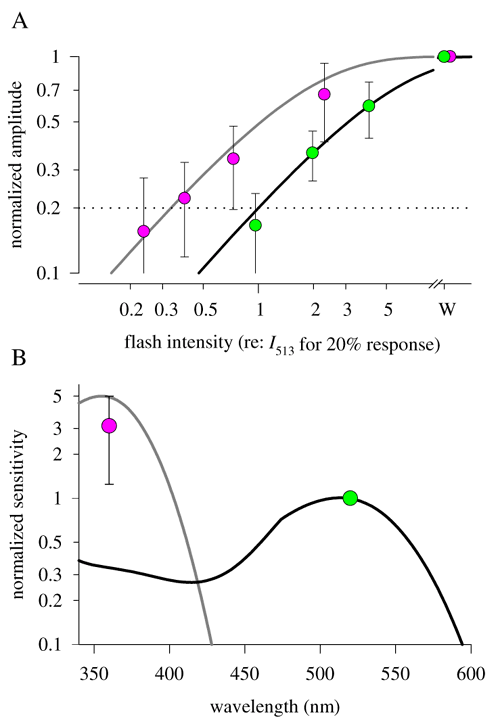![]() Figure 5 of
Lyubarsky, Mol Vis 2001;
7:71-78.
Figure 5 of
Lyubarsky, Mol Vis 2001;
7:71-78.
Figure 5. Sensitivity of RGS9-1 mice at the wavelength maxima of the UV- and M-cone pigments
A: Averaged amplitude vs. intensity data for RGS9-1 -/- mice (n=7) obtained with flashes of 361 nm (pink symbols) and 513 nm (green symbols), under cone-isolation conditions, as in Figure 4; the error bars are 90% confidence intervals. Peak amplitudes were measured after filtering the responses at 13 Hz to remove oscillations (see Methods). The peak amplitudes were normalized by dividing them by the saturating amplitude, obtained in response to the "white" flash ("W" on abscissa). The flash intensities were scaled by a single, common factor: this factor is the intensity at 513 nm (I513) estimated by linear interpolation to produce a response of 20% saturated amplitude (dotted line). Saturation functions (thickened black and gray curves), having the form rpeak/rmax = 1-exp(-kSlIl)have been plotted through the data, where Il is the scaled flash intensity, Sl is a wavelength-dependent sensitivity factor and k=0.22. The black curve was arranged to intercept the dotted line at the abscissa value 1.0, and thus has been positioned so that S513=1. The gray curve is shifted left by the average relative sensitivity of cone-driven responses of the RGS9-1 -/- mice to these two wavelengths, i.e., by the logarithm of the sensitivity ratio SUV/SM = S361/S513=3.0 (Table 1). B: The spectral sensitivity of cone-isolated b-wave responses of RGS9-1 -/- compared to WT. For each RGS9-1 -/- mouse, the lateral shift (in logarithmic units) between the two saturation functions best fitting its 513 nm and 361 nm data was measured. The point plotted at ~361 nm is the mean±95% confidence interval of these shifts; the point at 513 nm identifies the normalization position. The solid line gives the spectral sensitivities of the UV- and M-cone-driven b-wave responses of WT mice normalized to the sensitivity at 508 nm, as derived in [12].
